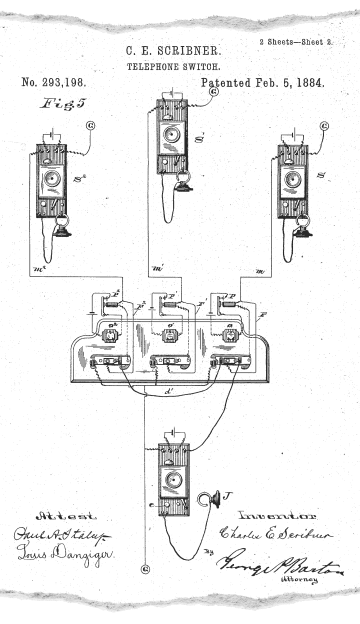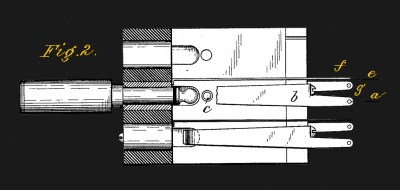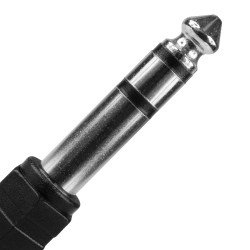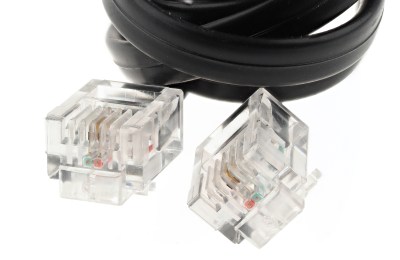While watching a video about old radios from the 1920s, a phone jack popped up. The host mentioned that phone jacks are super old and he wondered what was their origin. I always assumed they had something to do with the telephone system, and that’s right, but I had no idea how old they really are and how they’ve evolved. Turns out the venerable plug goes back to at least 1878.
Keep in mind, I’m talking about the good old fashioned 1/4″ phone jack with two wires. Over time, the jack and plug have spawned different versions with more wires and — particularly — smaller dimensions. The headphone jack that many smartphone makers are dropping is a direct descendant of that old phone jack. But a mono cable like you would see connecting an electric guitar or another mono source would be right at home connected to a 1900s switchboard. Let’s take a look at the origins of a design that’s almost 150 years old and still in use.
A Connector Design for the Long Haul
 There’s some debate over which switchboard was the first in operation. But in Boston or Connecticut, the year was around 1877 or 1878 and it used something recognizable as a phone plug. The word jack wasn’t in use yet, though. That came from Charles Scribner’s patent of a “spring jack” that allows the plug to open a switch contact. Some later documents also call it a jackknife switch, apparently since the plug is somewhat like a pocket knife. The advancement made life at the switchboard easier and is also the mechanism radios use to disconnect the speaker when you plug in headphones.
There’s some debate over which switchboard was the first in operation. But in Boston or Connecticut, the year was around 1877 or 1878 and it used something recognizable as a phone plug. The word jack wasn’t in use yet, though. That came from Charles Scribner’s patent of a “spring jack” that allows the plug to open a switch contact. Some later documents also call it a jackknife switch, apparently since the plug is somewhat like a pocket knife. The advancement made life at the switchboard easier and is also the mechanism radios use to disconnect the speaker when you plug in headphones.
 Scribner would go on to get more patents related to the plug, and the 1893 patent drawing looks like a modern plug and jack. As you might expect, all of these patents were assigned to the phone company.
Scribner would go on to get more patents related to the plug, and the 1893 patent drawing looks like a modern plug and jack. As you might expect, all of these patents were assigned to the phone company.
From Mono to Stereo
The plug is simplicity itself. Just two conducting cylinders with a small insulating ring keeping them apart. The shape of the tip pushes a spring-loaded retainer. As long as the plug and the jack have roughly the same idea of where the insulating ring is, everything will be fine.
 Of course, there was some variation in early designs, but the rounded tip quickly gained favor and would work with most jacks. The fact that the phone company was the primary source for these for decades made sure things were compatible, too. Not that they didn’t find wide application for headphones and even in the military.
Of course, there was some variation in early designs, but the rounded tip quickly gained favor and would work with most jacks. The fact that the phone company was the primary source for these for decades made sure things were compatible, too. Not that they didn’t find wide application for headphones and even in the military.
Of course, later, it was common to see a third ring to handle stereo audio. At first, the stereo plugs were given a sharper tip so it would be possible to build jacks that would not accept a mono plug. After all, plugging a mono cable into a stereo jack will short the right channel to ground. However, this was unworkable in practice and for many years now, mono and stereo plugs have the same sharper profile that originally meant stereo.
The Twenty-First Century and Beyond
We still have both the original phone jack and variants of all sorts. Until recently, most cell phones had a small variant of the phone jack with four conductors for a headset — usually known as TRRS for tip-ring-ring-sleeve. Many still do, at least for now. The phone company’s “cord board” probably would be unrecognizable to Scribner, but he could still find some of his plugs at the local guitar store.
It doesn’t help that many people call a “registered jack” (like an RJ-11 or RJ-45) a phone jack. Then there’s the “phono” plug and jack — which I’ve always called RCA connectors. Just remember the next time you plug in those high-end headphones, the plug in your hand has way over a century of heritage.
Of course, switchboards became much rarer with the ability to dial your own calls. Then came the answering machine.

















More years ago than I care to remember I happened upon a variation that was a bloody nuisance!
I had a Framus Star-Bass, and the non-replaceable jack socket wasn’t the 1/4″ I thought was completely universal by then, it was 6mm.
I had to turn down a couple of 1/4″ plugs to make a pair of leads so I had a spare, then guard them with my life against other members of the band because they were near enough to fit their gear, but theirs wouldn’t fit mine.
I probably would have just replaced the socket in the bass.
“the non-replaceable jack socket”
“I probably would have just replaced the socket in the bass.”
I concur, but I’d have tried drilling out the collar first, there’s probably half a millimetre more spring in the contacts even if the hole is a tad small.
Non-replaceable = get creative
NO USER SERVICEABLE PARTS INSIDE = there definitely is.
Warranty void if… = heh, cute.
@RW ver 0.0.1 — “Warranty Void If…” at least in the USA: no, it’s not, that’s complete and utter BS put in by manufacturers to fool people who don’t know the proper law — which is the Magnuson-Moss Warranty Act.
See https://www.digitaltrends.com/computing/ftc-warranty-stickers-illegal/ amongst other similar articles on the Web.
BTW, that law is also why eBay/etc generic ink cartridges likewise do not void your printer’s warranty despite the (identically complete and utter BS) scare-text splash screens you get when you use it… which basically boil down to “as the company that made this printer, we won’t cover damage from ink we didn’t actually sell you” which *is* technically true but that’s about the limit of it because that’s as far as the law will let them go.
Oh… bit of politics, BTW (sorry, can’t help it) — when a politician is swearing about how “regulations” are supposedly doing horrible things to corporations, what s/he really means is, taking away stuff like this will allow corporate profits to soar spectacularly because without such laws there’s absolutely nothing to prevent them from positively screwing you into the ground and telling you it’s your fault because you were using their product(s) — whether or not you actually have any real choice in the matter! — and what they are specifically *not* saying is that these “regulations” that are sooo like horribly inconvenient or whatev *drops hand* are there to protect consumers because the corporations are entirely too busy thickening their collective wallets to notice otherwise… purposefully so, and they like it that way.
Regulations are like broccoli — you may not like how the stuff goes down at first, but it’s not actually all that bad after a minute or two, and it’s remarkably good for you in the long run if you make at least a minor habit of it. Just avoid the prepackaged frozen stuff in the bag and you’ll be all right ;)
@ starhawk
No, the regulations they’re talking about are like these ones:
https://reason.com/2017/12/27/blow-drying-hair-in-arizona-requires-100/
https://reason.com/2015/06/11/the-con-of-certificate-of-need-laws/
https://reason.com/2016/04/05/rolling-back-occupational-licensing/
https://reason.com/2020/04/02/coronavirus-puts-counterproductive-regulations-into-perspective/
Regulations that provide no value and serve only to lock in the incumbent providers preventing competition, driving up costs.
I bought a bag full of switchboard ones from a radio rally and found they didn’t fit standard 1/4 holes. They sat on a shelf for 20 years and are probably still sitting somewhere.
Yes, there was a 3/16 inch diameter variation used for switching T1 digital circuits, a completely incompatible signal compared to the analog telephone audio but used in the same offices. You can see why they would want a different connector.
Incidentally, this is known as the “bantam” plug, and you’ll find numerous products under this name.
Possibly what you scored at the radio rally are civilian aviation microphone plugs which are .206 inches in diameter. My understand is that they were derived from an ancient telco standard. Presumably different diameters to differentiate the microphone from the headphone connector.
U.S. mil-spec standard which flowed to civilian aircraft.
You need the right angle version of those, so you don’t mar the cord when you hammer them in.
i decided to wiki phone plug…interesting reading
The third ring was not for stereo. It was developed for three-wire telephone hookups. Your phone was either the tip or the ring circuit, with the common shared.
I should be clearer here: the three wire was at the patch board. Only two wires went to the party line, and the board operator at in the office would ring the line (bell voltage) with one pattern for the tip customer, a different for the ring customer for incoming calls. I don’t recall how outgoing was handled. I was mighty young the last time I experienced this system.
A bit of history, Thank you.
IIRC, John Koss approached two stereo manufacturers to get them to incorporate the 1/4″ stereo plug in their equipment.
To increase his chances of success, he told each of them (separately) that the other company was going to put one in their next year’s equipment.
The following link does not mention that, I believe I read it decades ago in Stereo Review.
https://www.koss.com/history
Phone jacks and TRS connectors are NOT the same thing.
Darren:
Correct. Although they look somewhat similar they aren’t the same profile and dimensions.
Care to elaborate?
As 12AU76L6GC says they look similar but are in fact different. Phone plugs were extensively used in recording studio patch panels and other professional settings in the early days, with their distinctive ball shaped tip rather than the pointed type on a TRS. I believe there is some history as to the difference, it isn’t just that the phone plug design evolved into a TRS. I think the two were independently developed, possibly due to patents or possibly just because they had different uses. The phone plug lost market share over time, probably because most consumer products had TRS plugs and professional microphones started using XLR connectors leaving a shrinking market for phone plugs.
If you plug a phone plug into a TRS socket or vice versa it may work but will be terribly unreliable.
https://m.markertek.com/product/np3cm-b/neutrik-np3cm-b-trs-206-inch-mil-b-gauge-phone-plug-black-brass
Collins Radio used those for microphone connectors
One of the main features of jack fields in telephone and broadcast sites was jack normalling where when there wasn’t a plug inserted in the jack, the jack had switch contacts which connected the equipment in the associated racks in a normally wired circuit. As an example: a modulation limiter would be wired through a jack field with inputs and outputs connected say from the main mixing board to the studio transmitter link. If you wanted to bypass that limiter all you would have to do is plug in plugs in the jacks and it would select the inputs/outputs from the plugs and disconnect the “normalled” circuit for the limiter. This was pretty standard wiring up through the early 70’s but studio wiring then became a free for all and pretty pitiful.
The really amazing thing is that (with the exception of jack normalling) the jack field wiring standards of 1940’s through the 1970’s are almost identical to current IT “structured cabling” standards today. (MDF, IDF, vertical, horizontal distribution, etc.), just with UTP, STP and fiber circuits instead of balanced audio lines.
BTW, tip ring sleeve was always for sleeve being the shield and tip and ring being balanced audio until the 70’s where these standards went away and broadcasters opened the door to hum and noise from poorly designed unbalanced and unterminated circuits.
I find that engineers today have a hard time running audio from one room to another over twisted pair where in early broadcasting and phone circuits it was perfectly normal to run high fidelity wideband audio over balanced Telco lines at distances of 10 miles or more.
That’s fascinating! There’s so much history in electronics!
I wonder why wired digital audio isn’t far more common. Pretty much every time anyone uses an audio cable these days there’s noise. Balanced helps, but when you’re going from digital wireless mic to digital processing to a class-D amplifier, you wonder why you need so many conversions.
Dante and AES67 (multi channel audio over Ethernet) are becoming a de facto standard interconnect for studios and live shows with most new mixing desks supporting both. Essentially it replaces bundles of cables and jack plugs with RJ45s and switches.
And with normalling, there was (and still is) half normalled or fully normalled.
Half normalled means you can plug a patch cable into the top row and the internal connection to the bottom row remained therefore bridging the source. For circuits that were designed to be terminated into 600 ohms, this means you could lose a few DB of course.
Fully normalled means that patching a cable into either row breaks the internal patch between top and bottom row.
Best if your facility has either, but not both.
Correct.
Even when wired “full normalled” because the ring was larger in diameter than the transitions to the tip and sleeve, you could plug in partially and not deactivate the normal circuit and bridge to the loop with the plug. You lose 3 dB and change the impedance. This was very commonly done with high impedance audio level meters for alignment and trouble shooting.
Also, although it sounds like a minor thing it was much more important than it sounds.
If you plugged into any of the jackfields in the rack which would be the equivalent of a main distribution frame in today’s parlance, and measured the bridged audio level of any standard tone input or output in a jack, each and every single audio level would measure *exactly* 0 dBm at 600 ohms (with the exception of nonlinear devices such as compressors or limiters). Including feeds from studios, remote broadcast feeds, church audio feeds, national news feeds, everything. You could manually patch any input to any output or vice versa seamlessly and generally without hearing it in the audio. “Hot patching”.
I still have my wire wrap gun and unwrapping tool from building our local community radio station’s studios in the 70s. I actually got it from my dad who used it when he worked as a contractor for our local phone company.
Jack normalling is still a thing in audio. F’rinstance, I just got a semi-modular synthesizer that’s compatible with the Eurorack standard. It’s a straightforward analog synth with a classic signal chain, until you start plugging things into the patch bay and breaking the normalled paths. It’s even a standard practice to plug a cable going to nothing in to just disable the standard path — for instance, both VCOs are normalled to the volt/octave control voltage coming from the pads or MIDI input, so they’re always playing related notes; if you want the second VCO to instead be a constant drone, you plug something into the VCO2 Pitch jack, and disconnect that.
yeah, the days of running audio over telco is vanishing fast. We have T1 circuits that are difficult for our telco vendor to repair because a shrinking number of their technicians know about the dynamics involved. I know, but they won’t let me tell them how to fix it. They just end up running our circuit on another pair in the same bundle and wait until those decades old wires lose insulation bad enough to become hum generators.
Ah, these youngins. They’ll never know the struggle. They’ll never attempt it.
Absolutely. To be clear, we’re talking about extremely obsolete technology here with telco circuits you haven’t been able to order in at least 40 years. I’m with you on the T carrier circuits as well. Tick tock. The telcos aren’t supporting them and it’s time to let them go unless you have no other choice. But metro E and MPLS also have their challenges because the telcos don’t really understand prioritization and QoS for pro audio. To be fair, back in the day you generally couldn’t get a broadcast telco line equalized properly on the initial installation order either. it’s amazing how much things are different but certain parts don’t change.
Fascinating how genuinely versatile so much of this ‘old’ technology is and how it lends itself to cross-connectivity and therefore innovation. We seem to be losing that in a lot of electronics and computerised products these days, which has potentially bad consequences for improvised or accidental innovative working and thinking in the future…
Because anytime you even mention standardization, someone throws that XKCD at you! Standards proliferation is good thing, compared to everyone just doing things from scratch. 5 standards are better than 10 products with a unique connector.
I think we’re slowly gaining some of that versatility back now that USB and even Ethernet are cheap. What we really need is to make USB-C *reallllly* cheap, with little programmable breakout boards that give you 5-20v power and some GPIO/analog pins.
USB-C was pretty much made for this kind of versatility, but so far there’s not many DIY friendly and cheap things that take advantage.
USB-c is a good thing in many ways but have you ever tried to change a broken socket?
Never actually had a socket break with C. Eventually someone should just make a pure through hole connector that only has the power and legacy data pins.
Well I guess this just goes to show that a good design (or simple design) can last.
By the way, does anyone else think the cartoon at the top of the article looks quite philiac?
I mean that connector just is phallic in general. Not much to be done about it. Although they certainly did make it huge.
A case of unnatural convergent evolution perhaps?
No, it’s the 2001 obelisk thing, meant to look like it goes with the one on Mar’s…. wait a sec, Arthur C. Clarke you naughty man.
In my recall of this history the 1/4 inch plug started in France and included the standard of the relay-rack spacing width and other standards. If so in part or all it’s odd that they are in imperial units. It might have been because of Clement Ader the “Bell” of France whose plane was first to take off on it’s own power and made stereo sound in 1881! He used 2 telephone circuits so probably didn’t use a stereo jack.
Let’s start again…
Those are PHONO plugs, not ‘phone.’.
Also called 6.5mm for the metric types or P.O. jacks when they have the smaller tip connection used in telephone switchboards. (I suppose that could called a phone plug, except it’s not used with a phone).
The strict origin of the word phone is from ‘phonos’- the greek?/latin? word for ‘sound’
There were several iterations.
The earliest were from Morse code and then radio (wireless) receivers and they were mono (head)phone plugs.
The next were for early phonographs, tape and eventually records and these were also mono phono(graph) plugs.
The next were stereo (head)phone plugs.
In manual phone networks they were Tip Ring Sleeve (TRS) plugs.
In some countries the very early manual phone networks were run by the Post Office and hence the term P.O. plugs.
When I worked at the BBC in the 70s I discovered that the PO Jack had a slightly narrower ring than the 1/4″ Stereo jack then prevalent on headphones and HiFi, and on my Rickenbacker 4001S bass!. As a consequence if you plugged a PO jack into a stereo socket the ring might not make contact. If you did the opposite, most likely the ring contact would be bent and a PO Jack would then not work. I had to change such jacks due to crew bringing in their own headphones without permission. If they wanted to use their own ‘phones, we had to change the plug, and then they couldn’t use them at home. I believe the PO Jacks came first, and the Stereo version was easier to manufacture.
Not really. Phono jacks are almost as old as phone jacks and are what is today known as RCA connectors.
Phono(graph) jack – predates them all
(Head)pnone jack – a thing
(Tele)phone jack – looks nothing like this
TRS jack – was used in telecommunication equipment
RCA – is a audio Line (level) “socket” or a video baseband, or composite video, or component video or audio
the standard that came with RCA was a signal level of 1 mW of power across a 600 Ω impedance (approximately 0.7746 VRMS) for any signal be it audio or video. CD players were an exception though
ROB:
Not really in the early days. What we know as “RCA jacks” today were just a catch-all connector for DC, audio and RF in early radios and TVs. A main use was to connect early electromagnetic phono cartriges in record players to the preamp tubes. They were also used to connect the IF output from TV turret tuners to the chassis. Their use in the 70’s and beyond as a universal input and output audio connector was not based on any standards other than “provide a fairly low output impedance and load it with a high impedance in the downstream device and hope for the best”, which is a fairly Mickey Mouse concept. It generally works ok enough for home stereo. The 2 most recent levels are -10 dBV (no reference to impedance) and -3 dBV for equipment that pretends to be “prosumer” although the levels you get are what you get. Most RCA input impedances are in the range of 10 K ohms. Video generally tries to run 75 ohms but with RCA AV patch cables this too is an extreme compromise that works kind of ok for short runs if you aren’t too picky about performance.
What was and is meant by 0dBm at 600 ohms is a balanced circuit that requires a load of 600 ohms to yield the proper levels which also requires any long line transmission lines to be balanced and equalized (with capacitors and inductors) at 600 ohms as well. It is truly a lost art and with what passes as audio circuits (with the ground serving as audio return paths, ground loops etc.) , technology has stepped backwards in the quest for cheap.
Plugs in infinite orientations around one axis. Let’s see your USB-C do that!
That will be in USB-D
USB-D will have 23 concentric rings, all switchable to power or GPIO, and in the backshell to every connector and inside every jack will be a super smart little computer that will auto-negotiate and re-negotiate what sort of connection it will be. So one second it’ll be pumping out 50 amps then the next it’ll be a 100 gig full duplex data link.
Oh, like that shiz that R2-D2 pwned the Death Star with then.
50A 100Gbps ?? Someone PLEASE get this guy in the USB-D working group. :-D
Nah we’re gonna kidnap that guy from Sony who did the magic storage interface on the PS 5.
The issue with this is that as you plug them together, you get the contacts all shorting to each other randomly. That works for signals, but not for power.
Modern consumer-grade audio and professional telephone plugs and jacks have descended from specifications made by the Western Electric Company (WECO) around the turn of the 20th century.
Today there are two standard professional telephone plug/jack types that are still in wide use: “WECO 310” and “Bantam”. These professional plugs look a bit different in the tip/ring/shield (TRS) construction from anything you will typically find in a consumer TRS plug. The modern 1/4 inch “Phono” consumer plug/jack descends from the historic WECO 310 1/4 inch plug/jack:
– WECO 310: 0.25″ dia. (jack), 1.14″ long (plug) tip to base step.
– Bantam: 0.1875″ dia. (jack), 0.89″ long (plug) tip to base step.
Examples with pictures:
1. BNC (F) To Phone Plug (WECO 310) Pomona d2798_1_02.pdf
https://www.pomonaelectronics.com/products/telecom/bnc-f-phone-plug-weco310
2. BNC (F) To Bantam Plug Pomona d4719_1_02.pdf
https://www.pomonaelectronics.com/products/telecom/bnc-f-bantam-plug
I was vert entertained when I moved to Great Britain in 1979 and discovered telephones were plugged into the wall with a TRRS version of a plug that was shorter than the 1/4″ phone jack I was used to using for headphones and musical instruments.
Ode to the Miniature Jack [OC]
O mean audio jack, may we celebrate your fame?
no lower-case ‘i’ in front of your name.
I plug you in and you play, each time
Even if you happen to be covered in grime.
No pairing, no Bluetooth, no radio, no license
Just three and a half millimeters of gold-tipped niceness.
Born of Western Electric and the phone company Bell,
You deliver us from Apple and Android hell.
You play back in stereo, powering my pair-eo,
With allegro glissando contralto arpeggios.
Both ends the same, a reversible patois
I can turn you around and you still do the cha-cha!
While technically miniature,
Your stature’s on fire!
I would pick you on principle,
Over any other wire.
-MLM
Not really that old considering that the last recipient of a civil war pension just passed away. Mind you, she was 90, and her father was 84 when she was born. It is curious how we perceive social & technological history.
Apple, meet orange. Her death made the news precisely because of the “that old” thing.
When I saw the title I thought it was going to be about this kind of phone jack. https://www.youtube.com/watch?v=jZAsj1_RF2E
there seems to be a few types of TRRS out there
it’s only a few MM
it matters though!
I have a few devices, my QPix media player/recorder thingo especially, is really fussy
the TRRS cable that came with it is slightly longer, by 2MM?, only the QPix cable works
everything else is too short
the Sony miniDV cameras seem to have a weird quirk as well
Sony TRRS cables work, generic ones don’t
Sometimes it’s as simple as being a standard jack, but recessed in a narrow hole so the shells on most other generic connectors do not allow it to go home fully. TI calcs are a bit like that for the data cable, and had GPSes that only like slim micro or mini USB shells etc.
“While watching a video about old radios from the 1920s…”
Doesn’t provide a link.
Come on, man!
If you want to avoid the “phone plug” confusion. Call this a WECO 310 plug or jack. That would be the correct telco nomenclature for this.
Older thread, but I am working on a 1942 Holmes Projector amplifier. It has one of those 3/16″ phono plugs, by the female receptacle that is mounted on the cover tin, it looks to be TRS. I am trying not to alter or damage this amazing piece of history brought back from Europe after WWII. I appreciate the “Bantam” info and confirmation what it is I am looking at, now I need to acquire one. The unit (Holmes type L25N) also has speaker terminals that defy any pin or banana jacks I presently stock. Any good intel on where I can get military connecter specs/jargon/parts would be considered a blessing. Thanks in advance, Doc.